We are drawn to objects - shiny or not. Little keepsakes we collect become integral reminders of where we came from. When people leave our lives objects can be something tangible to keep their story alive. Often they are what separate fact from fiction.
Some objects take on a whole other purpose in our lives. We look at their service as though they were a living, breathing thing. We tend to personify them, like in Holling C. Holling's book Paddle to the Sea and Bill Mason’s iconic Canadian film adaptation that is one of my favourites.
https://youtu.be/uhjb1IG1pnQ
We try to get a sense of what they have witnessed, how they touched people’s lives, what they have had to endure and persevere to end up being in our presence today. We can document and witness its journey and the lives that have been touched.
Which brings us to the fishing schooner Marion Elizabeth, built in 1918 by Smith and Rhuland in Lunenburg, NS. Smith and Rhuland are the same company that built the famed Bluenose in 1921. This is a much bigger boat than little Paddle we all remember, but with just as diverse of a journey and story to tell.
The Marion Elizabeth was built for John Westhaver, a master mariner out of Lunenburg, NS, who named the ship after his wife and daughter. Westhaver, along with a handful of other shareholders, started the Marion Elizabeth Shipping Company Ltd. in 1925. The schooner traveled officially between Nova Scotia and Portugal.

The Marion Elizabeth, as seen in Margaree Harbour in the 1950s.
Although built as a “fishing” schooner, there were other more lucrative opportunities available at the time. Of the more notable chores the vessel was known for is smuggling gin during prohibition, where it was fired at on one occasion by the US Coast Guard. Gaff-rigged schooners were simple to sail, fast, and extremely versatile, making them the ideal choice for smuggling.
The schooner spent a considerable amount of time in Newfoundland fishing and transporting Cape Breton coal to various locations. In Nov of 1929 an earthquake hit the Burin peninsula in Newfoundland, followed by a tidal wave that killed 9 people. It is unclear if the ship was present but Burin was one of their main ports of operation during that period of time.
A story from Geoff May:
"The Bluenose and Marion Elizabeth were on the Grand Banks fishing , and ran out of supplies about the same time, and were both heading for Burin in rough seas. First come first serve in Burin, so Westhaver put out lots of sail, more than the Bluenose could handle in those seas , and got to port first. Westhaver later encountered Walters in town, neither saying anything as they walked past each other , but after he passed Walters yelled "there's no fool like an old fool" at Westhaver."
At some point the schooner was converted into a knockabout, with engines installed and a wheelhouse built. The topmasts and bowsprit were removed by Good People's Sea and Sail in North Sydney. Westhaver eventually sold the ship. It came into the possession of W.H.Roberts and an Eastman after his time.
In the 1950s the boat was about to take on a new life.
Ken Hansford, a well-to-do business man from Toronto, purchased a piece of land in Margaree Harbour and started a tourist shop along the Cabot Trail. As the popularity of the Paul Pix Craft Shop grew he added several more attached buildings.
He came into possession of the Marion Elizabeth and saw an opportunity to create a unique visitor experience. His plans were to beach the schooner on cement blocks to create a restaurant. The beaching didn't go well; there were complaints that Hansford hired local farmers to beach the boat instead of hiring local fishermen. During the move the boat was badly twisted, the masts were tearing a way at the superstructure and they had to be cut off at the roof line. The masts that were later erected were about half the size of the original ones .
Ken became a local art broker, commissioning work within the store, including those of Elizabeth LeFort, the famous Cheticamp rug-hooking artist, who he eventually married. His influence and connections put her work on the international stage.
Kwf40_12.JPG)
Paul Pix and Schooner Restaurant.
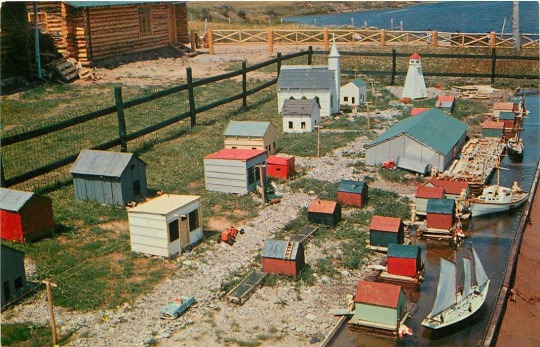
Small fishing village display set up outside of the Schooner Restaurant
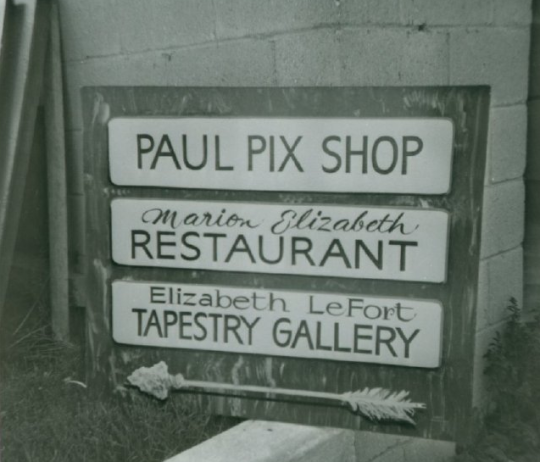
Elizabeth LeFort and her works were showcased on site.
Paul Pix and the Schooner Restaurant were a hub of activity, but by the late 1960s upkeep and regulations became a challenge. The operations were closed by the provincial health department for several years.
This brings us to the story of John and Stephanie May, the parents of well-known politician Elizabeth May and her brother Geoffrey. Stephanie was one of the most prominent political activists in Conneticut while John was the Assistant Vice President of Aetna Life and Casualty. Concerned about John’s high blood pressure and the confinement of a 9-5 job. the Mays moved to Cape Breton to resuscitate the business. The cost was high, to the tune of $165,000. The Mays built a complete sewage treatment plant to fix the restaurant’s problems, plus made massive renovations to the gift shop, so that the tourism complex could be re-opened and provide a major boost to employment in the Margaree area.
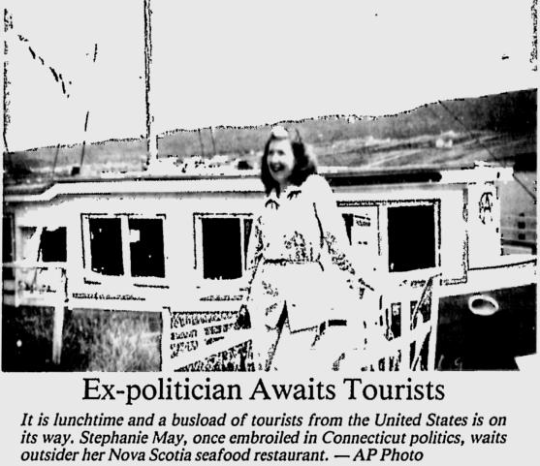
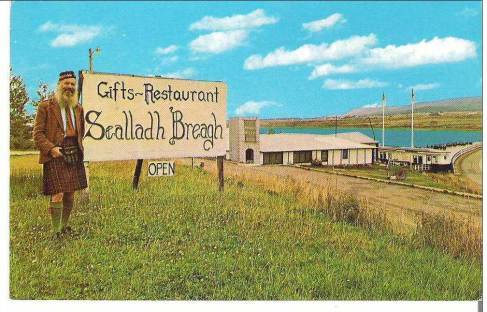
Above: Pictures of Stephanie May and John May promoting their business.
The schooner, with a few repairs, and some major changes to the interior, was a big tourist attraction once again, with a dining room on the deck and the Schooner Museum in the hull as part of the Sealladh Breagh stop. The Mays focused on experience and promotion of the Gaelic culture. During the visitor season a piper would greet people daily at the door to the newly store. Elizabeth May mentions her first jobs were as a cook and waitress in the restaurant. Beside the schooner was Farley Mowat’s boat The Happy Adventure, that was showcased in his novel The Boat That Wouldn’t Float. The place was known locally as “Schooner Village.”
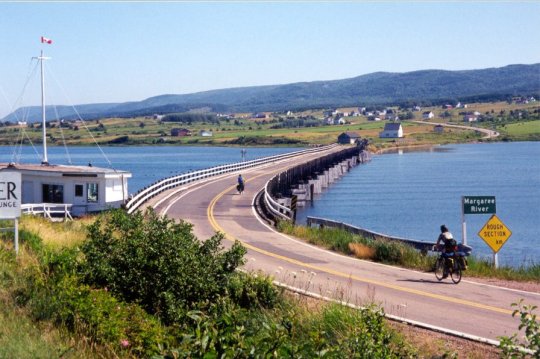
Schooner Restaurant as it was in 2001.
An excerpt from a 1982 article in the Hour, a Conneticut newspaper:
“As the travelers enter the dining room they are led by a teenage boy attired in kilts and playing bagpipes. After the guests are seated the piper accompanies a young girl who dances the highland fling.
As the diners begin their meal, the restaurant’s owner, a middle-aged woman, walks quietly to the piano. When the piper has finished, she starts to play, filling the room with the music of Cole Porter, Jerome Kern and Richard Rogers.”
People found the food great and the atmosphere welcoming. The Financial Post rated the Marian Elizabeth Schooner’s chowder the best in Canada. There are many notable memories about the place, particularly the evening festivities of Celtic Music.
Unfortunately, after several successful years of business, the restaurant and gift shop were expropriated in 2002 to make room for a new bridge across the Margaree River.
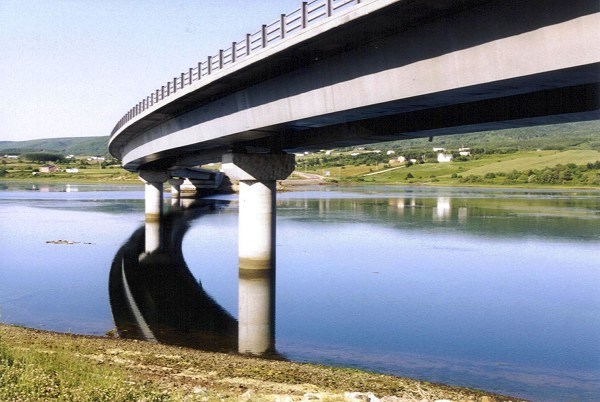
Bridge as seen from an area close to where the Schooner Restaurant once stood.
There was lobbying by the Mays to seek funding to either move the boat or build around it. At the time, the Marion Elizabeth was known as the last example of a Bluenose style schooner still in existence, even though it had undergone a number of modifications. Many believed that the schooner was not salvageable and wouldn't transport well. Sadly, after it was expropriated and turned over to the province the gift shop, Marion Elizabeth and The Happy Adventure were demolished and hauled off to the local landfill. Geoff mentioned to me that he had hoped to save Farley's Boat but was only given two months to empty all of the buildings and couldn't get a crane to the location in time.
The storied history of the schooner is destined to the sands of time and, eventually the study of local legend and folklore. But for now this story remains in the hearts of those who have had the opportunity to touch a piece of important history.
I wanted to thank a few people for helping to add details to the story, including Geoff May, Peter Sheehan and Marie Blackie. One of the real pleasures for me is putting something out there and having people add to the discussion and story.
Chris Bellemore is a blogger from Ontario that moved to Cape Breton Island and is logging his experiences in this strange and wonderful place.
Folllow me here: @thisiscapebreton thisiscapebreton.com

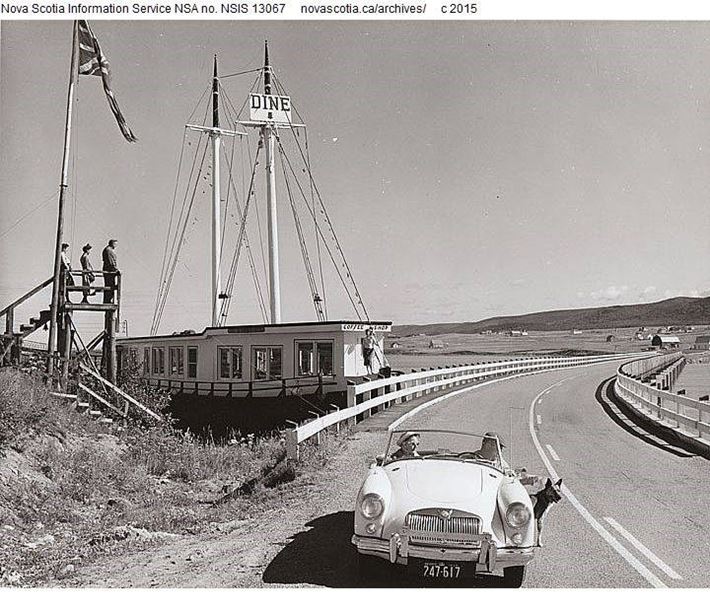



6
Log In or Sign Up to add a comment.- 1
arrow-eseek-e1 - 2 of 2 itemsFacebook Comments